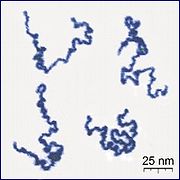
Back Polimeer Afrikaans مبلمر Arabic Polímeru AST Polimerlər Azerbaijani پولیمر AZB Polimero BCL Палімеры Byelorussian Палімэры BE-X-OLD Полимер Bulgarian পলিমার Bengali/Bangla
| Polymer science |
|---|
 |


A polymer (/ˈpɒlɪmər/[2][3]) is a substance or material consisting of very large molecules called macromolecules, composed of many repeating subunits.[4] Due to their broad spectrum of properties,[5] both synthetic and natural polymers play essential and ubiquitous roles in everyday life.[6] Polymers range from familiar synthetic plastics such as polystyrene to natural biopolymers[7] such as DNA and proteins that are fundamental to biological structure and function. Polymers, both natural and synthetic, are created via polymerization of many small molecules, known as monomers. Their consequently large molecular mass, relative to small molecule compounds, produces unique physical properties including toughness, high elasticity, viscoelasticity, and a tendency to form amorphous and semicrystalline structures rather than crystals.
Polymers are studied in the fields of polymer science (which includes polymer chemistry and polymer physics), biophysics and materials science and engineering. Historically, products arising from the linkage of repeating units by covalent chemical bonds have been the primary focus of polymer science. An emerging important area now focuses on supramolecular polymers formed by non-covalent links. Polyisoprene of latex rubber is an example of a natural polymer, and the polystyrene of styrofoam is an example of a synthetic polymer. In biological contexts, essentially all biological macromolecules—i.e., proteins (polyamides), nucleic acids (polynucleotides), and polysaccharides—are purely polymeric, or are composed in large part of polymeric components.

- ^ Roiter, Y.; Minko, S. (2005). "AFM Single Molecule Experiments at the Solid-Liquid Interface: In Situ Conformation of Adsorbed Flexible Polyelectrolyte Chains". Journal of the American Chemical Society. 127 (45): 15688–15689. doi:10.1021/ja0558239. PMID 16277495.
- ^ "Polymer – Definition of polymer". The Free Dictionary. Retrieved 23 July 2013.
- ^ "Define polymer". Dictionary Reference. Retrieved 23 July 2013.
- ^ "Polymer on Britannica". 25 December 2023.
- ^ Painter, Paul C.; Coleman, Michael M. (1997). Fundamentals of polymer science: an introductory text. Lancaster, Pa.: Technomic Pub. Co. p. 1. ISBN 978-1-56676-559-6.
- ^ McCrum, N. G.; Buckley, C. P.; Bucknall, C. B. (1997). Principles of polymer engineering. Oxford; New York: Oxford University Press. p. 1. ISBN 978-0-19-856526-0.
- ^ Saberi, A.; Bakhsheshi-Rad, H.R.; Abazari, S.; Ismail, A.F.; Sharif, S.; Ramakrishna, S.; Daroonparvar, M.; Berto, F. A Comprehensive Review on Surface Modifications of Biodegradable Magnesium-Based Implant Alloy: Polymer Coatings Opportunities and Challenges. Coatings 2021, 11, 747. https://doi.org/10.3390/coatings11070747
© MMXXIII Rich X Search. We shall prevail. All rights reserved. Rich X Search